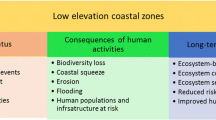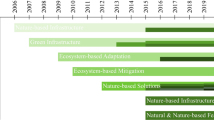Abstract
Beaches are frequently subjected to erosion and accretion that are influenced by coastal development interventions and natural variations due to storms and changes in river flow. Climate change may also exacerbate beach erosion and accretion. Natural scientists are concerned with the sustainability of species dependent on the beach ecosystem. Policymakers are pre-occupied with the economic sustainability of coastal communities should species decline and prolonged beach loss occur. The aim of this paper is to explore the linkage between science and policy by reporting the findings of a study of coastal change impacts on leatherback turtle nesting and analysing the socio-economic and adaptation implications of these changes for coastal communities. Grande Riviere, Trinidad, was used as a case study. Primary fieldwork investigated unsustainable coastal management practices. A questionnaire was administered to examine livelihoods, including ecotourism based on leatherback turtle nesting, and knowledge and awareness of climate change. One key finding of the study was that the community’s livelihoods were natural resources dependent, and that natural beach dynamics and unsustainable coastal management practices posed major threats to natural resource and economic sustainability. Another key finding was that, despite these impacts, community knowledge and awareness of climate change in general was low, and there was a perception of state responsibility for climate change adaptation. The research findings have global applicability for coastal communities at risk of exposure and that are highly vulnerable to natural resources damage arising from anthropogenic stress and potential climate change. These communities require policy reforms to strengthen current coastal management practices and adaptation responses aimed at ensuring long-term sustainability.




Similar content being viewed by others
Notes
The International Community-University Research Alliance (ICURA) project on Managing Adaptation to Environmental Change in Coastal Communities: Canada and the Caribbean, also called the C-Change Project, links community members and university researchers from Canada with members of the Caribbean community in support of research on coastal adaptation to environmental change, including the impacts of storm surge and sea-level rise on susceptible coastal communities. Michael Sutherland has mapped the projected SLR at Grande Riviere as part of the research.
The survey forms part of the International Community-University Research Alliance (ICURA) project on Managing Adaptation to Environmental Change in Coastal Communities: Canada and the Caribbean.
References
Abuodha PAO, Woodroffe CD (2010) Assessing vulnerability to sea-level rise using a coastal sensitivity index: a case study from southeast Australia. J Coast Conserv 14(3):189–205
Bacon PR (1969) The leatherback turtle project, progress report 1967–1968, and recommendations. J Trinidad Field Nat Club 8–9
Bacon PR (1970) Studies on the leatherback turtle, Dermochelys coriacea (L.), in Trinidad, West Indies. Biol Conserv 2:213–217
Bacon PR (1981) The status of sea turtle stocks management in the Western Central Atlantic. WECAF Studies no. 7. Interregional Fisheries Development and Management Programme, Panama
Becken S, Hay JE (2007) Climate change-related risks and adaptation. In: Becken S, Hay JE (eds) Tourism and climate change: risks and opportunities. Channel View Publications, Clevedon, pp 223–260
Cambers G (1999) Coping with shoreline erosion in the Caribbean. Nat Resour 35(4):43–49
Cambers G, Muehlig-Hofmann A, Troost D (2003) Coastal land tenure: a small-islands’ perspective. Report prepared for UNESCO-CSI and the University of Puerto Rico Sea Grant College Program, UNESCO, Paris
Christensen JH, Hewitson B, Busuioc A, Chen A, Gao X, Held I, Jones R, Kolli RK, Kwon W-T, Laprise R, Magaña Rueda V, Mearns L, Menéndez CG, Räisänen R, Rinke A, Sarr A, Whetton P (2007) Regional climate projections. In: Climate Change 2007: The Physical Science Basis. Contribution of Working Group I to the Fourth Assessment Report of the Intergovernmental Panel on Climate Change. Cambridge University Press, Cambridge
Chu Cheong L (1990) Observations on the nesting population of leatherback turtles Dermochelys coriacea in Trinidad. Carib Mar Stud 1:48–53
De Souza G (2001) Tropical cyclones affecting Trinidad and Tobago, 1725 to 2000. Brochure of the Meteorological Service of Trinidad and Tobago
Eckert SA, Eckert KL (2005) Size and status of insular Caribbean leatherback nesting populations. Atlantic Leatherback Strategy Retreat. Available online at: http://www.conserveturtles.org/pdf/presentations/EckertPresentation.pdf. Accessed 14 Jan 2013
Fish MR, Côté IM, Horrocks JA, Mulligan B, Watkinson AR, Jones AP (2008) Construction setback regulations and sea level rise: mitigating sea turtle nesting beach loss. Ocean Coast Manag 51:330–341
Fournillier K, Eckert KL (1998) Draft WIDECAST sea turtle recovery action plan for Trinidad and Tobago. United Nations Caribbean Environment Programme, Kingston
French PW (2006) Managed realignment: the developing story of a comparatively new approach to soft engineering. Coast Shelf Sci 67(3):409–423
Fuentes MMPB, Cinner JE (2010) Using expert opinion to prioritize impacts of climate change on sea turtles’ nesting grounds. J Environ Manage 91:2511–2518
Ganase SA, Teelucksingh SS (2011) Linking vulnerability, adaptation, and mitigation in small island developing states: climate change and the community of Grande Riviere, Trinidad. Available online at: http://www.ccmf-uwi.org/files/publications/conference/2011/8_3-Ganase_Teelucksingh-p.pdf. Accessed 9 Feb 2012
Godley B, Broderick A, Blackwood S, Collins L, Glover K, McAldowie C, McCulloch D, McLeod J (1993) 1991 Survey of marine turtles nesting in Trinidad and Tobago. Mar Turt Newsl 61:15–18
Government of Trinidad and Tobago (2010) WIDECAST Sea turtle recovery action plan for Trinidad and Tobago. In: Eckert KL (ed) CEP Technical Report No. 49
Harrison D (2007) Cocoa, conservation and tourism Grande Riviere, Trinidad. Ann Tour Res 34(4):919–942
Hawkes LA, Broderick AC, Godfrey MH, Godley BJ (2009) Climate change and marine turtles. Endanger Species Res 7:137–154. doi:10.3354/esr00198
Hay JE, Mimura N (2006) Supporting climate change vulnerability and adaptation assessments in the Asia-Pacific region: an example of sustainability science. Sustain Sci 1:23–35. doi:10.1007/s11625-006-0011-8
Hay JE, Mimura N, Campbell J, Fifita S, Koshy K, McLean RF, Nakalevu T, Nunn P, de Wet N (2003) Climate variability and change and sea-level rise in the Pacific Islands region. A resource book for policy and decision makers, educators and other stakeholders. South Pacific Regional Environment Programme. Ministry of the Environment, Japan
Institute of Marine Affairs (2004) A guide to the beaches and bays of Trinidad and Tobago. Publication of the IMA Trinidad and Tobago, Chaguaramas
Intergovernmental Panel for Climate Change (IPCC) (2007) Climate change 2007: Synthesis Report. Available online at: http://www.ipcc.ch/pdf/assessment-report/ar4/syr/ar4_syr.pdf. Accessed 28 Sept 2012
Lee Lum L (2001) Beach dynamics and nest distribution of the leatherback turtle (Dermochelys coriacea) at Grande Riviere Beach, Trinidad and Tobago. Rev Biol Trop 53(Suppl 1):239–248
Livingstone SR, Downie JR (2003) Marine turtle conservation on the North Coast of Trinidad. Division of Environmental and Evolutionary Biology, University of Glasgow. Available online at: http://www.britishcheloniagroup.org.uk/testudo/v6/v6n2livingstone. Accessed 17 Jan 2013
McSweeney C, New M, Lizcano G, Lu X (2012) United Nations Development Programme Climate Change Country Profiles Trinidad and Tobago. Available online at: http://country-profiles.geog.ox.ac.uk. Accessed 4 Feb 2013
Nathai-Gyan N, James C, Hislop G (1987) National report for the country of Trinidad and Tobago to the Western Atlantic Turtle Symposium II, Mayaguez, Puerto Rico, October 1987
Pantin D, Brown D, Mycoo M, Gobin JF, Toppin-Allahar C (2004) Feasibility of alternative sustainable coastal resource-based enhanced livelihood strategies: final technical report, Port of Spain Trinidad
PLANVIRON Limited (1999) Carrying capacity study for the north and northeast coasts of Trinidad, Port of Spain Trinidad
Poloczanska ES, Limpus CJ, Hays GC (2009) Vulnerability of marine turtles to climate change. In: Sims DW (ed) Advances in marine biology. Academic Press, Burlington, pp 151–211
Pulwarty RS, Nurse LA, Trotz UO (2010) Caribbean islands in a changing climate. Environment: science and policy for sustainable development. Available online at: http://www.environmentmagazine.org/Archives/Back%20Issues/November-December%202010/caribbean-islands-full.html. Accessed 13 March 2010
Ramdath AD, Baban SMJ, Agard J (2004) A preliminary investigation to the possible impact of el Niño/southern oscillation (enso) phenomena on the climate of Trinidad and Tobago using remotely sensed data. Available online at: http://www.bvsde.paho.org/bvsacd/cef-2/ARenso.pdf. Accessed 13 Jan 2013
Richards MJ, Hosein R (2011) Mt. Plaisir Estate Hotel: a catalyst for development in Grand Riviere. Available online at: http://growinginclusivemarkets.org/media/cases/Trinidad_Mt.Plaisir_2008.pdf. Accessed 24 Sept 2012
Sutherland M, Dare P, Miller K (2009) Monitoring sea level change in the Caribbean. Geomatica 62(4):428–436
Trinidad & Tobago Guardian (2012) Experts split on Grande Riviere action. Available online at: http://www.guardian.co.tt/news/2012-07-12/experts-split-grande-riviere-action. Accessed 7 July 2012
Acknowledgements
The authors wish to acknowledge the contribution of Gabrielle Thongs in ensuring that the figures met publication requirements. Ms. Thongs is a graduate research assistant at the University of the West Indies, St. Augustine, Trinidad, where she is pursuing a Ph.D. degree in Geomatics Engineering.
Author information
Authors and Affiliations
Corresponding author
Additional information
Handled by John E. Hay, Ibaraki University, Japan.
Rights and permissions
About this article
Cite this article
Mycoo, M.A., Gobin, J.F. Coastal management, climate change adaptation and sustainability in small coastal communities: leatherback turtles and beach loss. Sustain Sci 8, 441–453 (2013). https://doi.org/10.1007/s11625-013-0212-x
Received:
Accepted:
Published:
Issue Date:
DOI: https://doi.org/10.1007/s11625-013-0212-x




